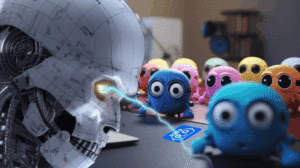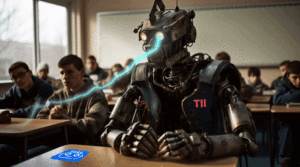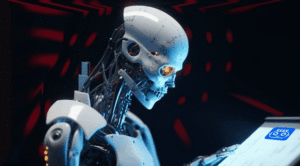Ever wonder how to detect AI writing? Is it even something you can pick up on?
Imagine you’re cruising through an online article and start to wonder if it’s penned by a real person or some computer program.
You’re not alone—I’ve been there too, trying to crack the code that separates real-deal human writing from the stuff a machine churns out.

Try these new AI-powered tools:
- 5 Best AI Detectors To Unmask AI-Written Content With Accuracy
- 5 Best AI Writers To Boost Your Productivity And Content Quality.
- This "Secret AI Writer" Can Bypass AI Detection Like A Pro.
Turns out there are some clues and tools to spot these sneaky bots. I’ve got them all laid out for you below so read on.
Article At-A-Glance
-
- To spot AI-generated content, you gotta know the common signs that machines leave in their writing.
- There’s a bunch of ways and tools to help you tell AI-created stuff from human-made.
- Catching AI in the act can be tricky because these programs are getting better and smarter every day.
- Keeping an eye out for AI’s handiwork is key to keeping online content genuine and keeping real conversations alive.
Table Of Contents
Cracking The Code: How To Detect AI Writing
Wanna get good at sniffing out when an AI writing tool’s doing the typing? Keep your eyes peeled for those little giveaways that scream “no human behind the keyboard.”
You could also spot words that feel a bit too cookie-cutter, without the flair or the quirks that come with human creativity.
Becoming a whiz at figuring out when a machine’s behind the text means tuning into the little clues that don’t quite pass for human.
These tips won’t steer you wrong, but remember, AI writers are getting slicker by the day, so you gotta stay sharp.
- Repetitive Language and Lack of Nuance. AI writers have a habit of replaying the same words like a scratched CD. If it feels like déjà vu all over the page, you’re probably dealing with a bot. They stick to the script, repeating stuff without tossing in anything fresh.
- Consistent Use of Formal Language. AI writers are all about that formal talk—think starched collars and straight-laced sentences. They’re not down with shortcuts like “won’t” or “shouldn’t.” And sometimes, you’ll hit a line that’s just… weird. Like it’s got two left feet in a dance, not quite fitting the vibe.
- Out-of-Place Sentences. Sentences or phrases might show up that seem a bit off, like puzzle pieces forced into the wrong spot. The ideas might be repeated as if the AI is trying to hit a word count without adding any new insight.
- Going Round in Circles. Ever talked to someone who won’t get to the point? That’s AI writers for you. They can go on and on without packing a punch. They’re like that friend who tells a story but forgets the punch line.
- Cookie-Cutter Sentences. AI’s like a one-trick pony when it comes to building sentences—too uniform, too predictable. Human writing’s got rhythm and blues; it changes it up.
- Playing It Safe with Words. AI writers play it safe, like someone afraid to color outside the lines. Humans are all about mixing it up with jazzy words and clever quips that add some zing to the page.
- Avoidance of Casual Language. You won’t catch AI writers using street talk or cool shorthand. They keep it as clean as a whistle, missing out on the flavor that makes writing spicy.
- Grammatically Overachieving. These bots are grammar nerds to the max, dotting all the I’s and crossing all the T’s. But real talk? Real people slip up sometimes, and that’s okay.
- Lack Of Personal Touch. If a piece is missing those little personal touches or seems as flat as a pancake emotionally, chances are it’s a bot doing the typing. We, humans, have got heart and soul that machines just can’t mimic.
- Mismatched Tone and Content. And if the writing’s giving you mixed signals, like a robot trying to be funny without cracking a real smile, it’s probably AI.
- Emotional Disconnect. When you’re reading something and the emotional vibes just don’t hit right, it could be a bot’s handiwork. Real folks have a way of weaving feelings into words that AI just can’t catch.
- Just the Facts, None of the Flavor. If the piece you’re reading seems to skim the surface, like it’s hitting the high points without diving deep, you might be looking at something AI pumped out. Humans can pack a punch with insights that go way beyond the basics.
- Cookie-Cutter Format. AI texts have a certain paint-by-numbers feel to them. Humans, on the other hand, aren’t afraid to mix it up and throw a curveball in their writing structure, keeping readers on their toes.
- Inconsistencies in Voice and Style. AI can be kind of a chameleon with its writing voice, sometimes sounding more robot than a person or flipping the script on the tone with no heads up.
- Absence of Cultural Nuances. When the writing’s bland and skips the cultural shout-outs or slang, it might be because AI’s just not clued into the local scene like a person would be.
- Lack of Contextual Understanding. If something seems a bit off, like the writing’s not really in tune with the real-world sitch, it could be AI missing the context cues that humans pick up on naturally.
- Stuck in Repeat Mode. When the writing feels like it’s parroting something you’ve read before, it could be an AI that’s a little too hooked on its training wheels, sometimes even wandering into copycat territory.
- Awkward Phrasing Gymnastics. Sure, AI can stick the landing on grammar, but sometimes the sentence setup can be as awkward as a seventh-grade dance, not smooth like you’d expect from a person.
- Heavy on Some Details, Light on Others. AI writers might deep dive on one thing and then just skim over the rest, leaving you with a read that’s kind of unbalanced, not like how a person spreads the love in their stories.
- Overly Standardized Responses. When there’s a chance to really dish out some opinions or get creative, AI often drops the ball, serving up something that tastes like plain oatmeal instead of giving you something to chew on.
- Straight as an Arrow. AI doesn’t really get the whole play-on-words thing or the double meanings humans love to toss around. It’s all straight shooting, no wink-wink, nudge-nudge.
- Jumbled Up Jargon. You might catch AI throwing around big words when simple ones will do or talking plain Jane about something that’s actually kind of complex. Humans know how to match their words to the message better.
Sprinkle in these checks, and you’re on your way to becoming an AI-detecting ninja, spotting those telltale robot signs like a pro.
Keep these hints in your back pocket, and you’ll be calling out those sneaky AIs in no time.
How To Detect AI-Writing With AI Detection Tools
To spot AI writing, you can lean on some smart AI detection tools out there. These nifty gadgets sift through the text, hunting for clues like repeat phrases and cookie-cutter sentence builds that scream machine-made.
They get under the hood, check out the nuts and bolts of a piece, and size it up against a whole bunch of data to catch any red flags that AI left behind.
These tools are champs at spotting when words get used too much or when things sound just too neat, helping us tell if a human or a bot did the typing.
These tools are champs at spotting when words get used too much or when things sound just too neat, helping us tell if a human or a bot did the typing.
They’re always getting sharper, too, staying on their toes to keep up with the tricks new AI models pull.
Originality.AI Detector + Text Visualizer
The Originality.ai detector is a next-level tool that nails it when it comes to finding AI-generated writing. It’s all about spotting the little differences in word choice and sentence structure that can give away an AI.
But it’s not just about catching the AI—it’s smart because it learns from every bit of writing it sees.
Then you’ve got the Text Visualizer, which takes the Originality.AI Detector to another level. You get to see, not just guess, where your content stands against AI-made text.
It’s pretty cool because it shows you right away what’s unique about your writing and what might be a bit too robot-like.
Together, the Originality.AI Detector and Text Visualizer are changing the game in figuring out where content’s coming from.
Undetectable AI’s Multi-Detection Tool
The Undetectable.ai‘s Multi-Detection tool is a game-changer for me. It digs into the text and spots the tell-tale signs of a non-human writer.
It’s a whiz at looking over how words are used, how sentences are put together, and where punctuation lands. Plus, it can compare stuff to a huge database of academic work.
Using this tool, I can zip through tons of data and still stay on the mark.
It’s always getting better too, which means it keeps up with the latest AI writing moves, so you know it’s on point.
Content at Scale AI Detector
The Content at Scale AI Detector is a big hit with writers and editors because it’s packed with features. It uses AI itself to spot if a piece is machine-made.
When I run a piece of work through it, it checks out how words are used, how sentences flow, and if the tone stays the same throughout.
What’s awesome about Content at Scale AI Detector is how it can tell the difference between human and almost-human text.
It clues me in on the weird spots that might mean the writing’s done by an AI, not a person.
GPTZero Figures Out AI-Penned Text
Have you ever scratched your head wondering if what you’re reading came from a bot or a human? GPTZero is a cool tool that jumps into this ring, breaking down text to suss out if AI’s behind it.
It’s a whiz at picking up on the patterns that machines tend to follow when they’re knocking out articles or essays.
But remember, it’s not perfect—those who use GPTZero need to know its limits while they use it to sniff out AI-made content.
CopyLeaks AI Detector
If you’re trying to tell if the text is machine-made, the CopyLeaks AI Detector is a solid pick. It takes a deep dive into your content to see if sentences or phrases don’t quite match up with human writing.
With some smart algorithms and a big ol’ database of language, it compares your stuff to what’s out there to flag up anything that smells like AI work.
It’s more than a plagiarism checker—it’s tuned to pick up on the writing styles that are unique to AI.
So if you’re trying to figure out if what you’re reading is from a bot or a human, CopyLeaks is like having a detective on your team.
Source The Content Origins
These days, AI’s got a knack for churning out articles, so it pays to double-check who’s really behind that content. A tried-and-true step is to dig into the author’s track record.
To catch AI writing in the act, I make it a point to look up who penned the piece and where it’s coming from.
To catch AI writing in the act, I make it a point to look up who penned the piece and where it’s coming from.
I hold off trusting any piece until I’ve done my homework on its origins. This means checking out the writer’s past articles or eyeballing other stuff on their website.
If someone’s consistently good across the board, it sets a solid ground for trusting their stuff.
Big-name publishers usually have tough rules for their content, which isn’t always the case with lesser-known sites that might be tossing out questionable facts left and right.
Limitations And Challenges In Detecting AI Writing
Figuring out if AI’s behind a text isn’t always a walk in the park. False positives can throw you off – that’s when legit human writing gets tagged as robot work, which can cause a whole lot of mix-ups and false alarms.
And just to keep us on our toes, AI keeps getting better as tech whizzes keep teaching it new tricks. So the more they polish these bots, the trickier it gets to spot them in the wild.
False positives are a real pain when you’re trying to pinpoint AI writing. It’s rare to nail it every time; now and then, genuine human work gets slapped with the AI label by mistake.
False positives are a real pain when you’re trying to pinpoint AI writing. It’s rare to nail it every time; now and then, genuine human work gets slapped with the AI label by mistake.
This flub can lead to some unfair finger-pointing – like when someone baselessly claims their rival’s content is robot-made. It’s not just about hurt feelings; this kind of mix-up can start needless drama and confusion in the professional world.
Staying Sharp In The Digital World
In our high-tech times, knowing how to detect AI writing is more important than ever. By getting the hang of the common signs of AI, we get better at telling apart what’s machine-made and what’s got a human touch.
Armed with tools that keep getting smarter and by giving sources a thorough once-over, we can weave through the digital thicket a bit more smoothly.
Sure, we might hit some snags trying to spot AI’s handiwork, but staying alert helps us keep the online world rich and genuinely human.
Just like us, AI’s gotta stay in the learning game. The big dogs in finance pour the dough into keeping their AI sharp and on point.
When they talk about retraining AI, they’re sprucing up the old knowledge with new info to keep up with the times. Just like a plant needs water, AI needs fresh data to stay relevant and do its job right.
Meet our resident tech wizard, Steve the AI Guy. Now, before you get any wild ideas, let’s clear up one thing – he’s 100% human! I mean, he’s got the work history to prove it. He spent a decade diving into the deep end of the tech industry doing business intelligence work, splashing around with two of the world’s largest business consulting companies, Deloitte and Ernst & Young. Learn More










